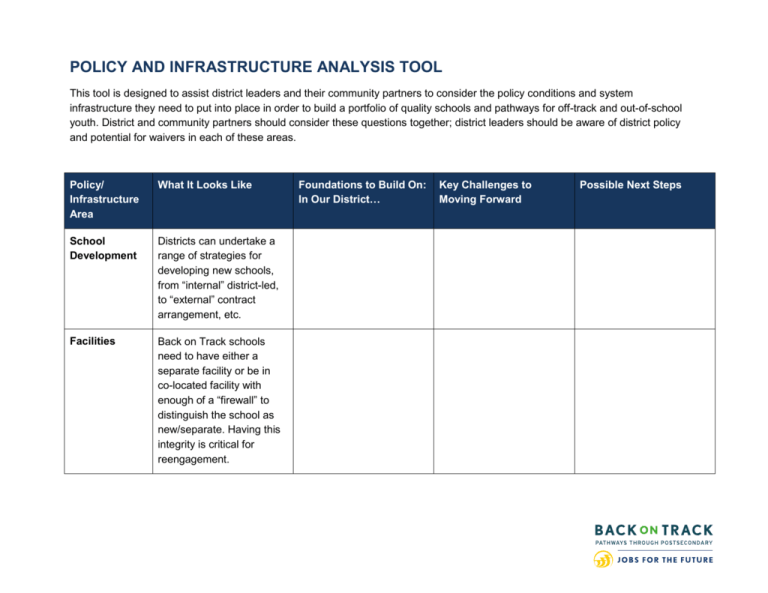Policy and Infrastructure Analysis Tool
advertisement

POLICY AND INFRASTRUCTURE ANALYSIS TOOL This tool is designed to assist district leaders and their community partners to consider the policy conditions and system infrastructure they need to put into place in order to build a portfolio of quality schools and pathways for off-track and out-of-school youth. District and community partners should consider these questions together; district leaders should be aware of district policy and potential for waivers in each of these areas. Policy/ Infrastructure Area What It Looks Like School Development Districts can undertake a range of strategies for developing new schools, from “internal” district-led, to “external” contract arrangement, etc. Facilities Back on Track schools need to have either a separate facility or be in co-located facility with enough of a “firewall” to distinguish the school as new/separate. Having this integrity is critical for reengagement. Foundations to Build On: In Our District… Key Challenges to Moving Forward Possible Next Steps Staffing Historically, principals have not had hiring autonomy and teachers have often been placed in these schools; Effective schools should be able to hire/fire their own staff. Budget Effective schools have, at a minimum, equity in funding and, at best, have enriched funding through a range of sources: weights, and braided funding from other funding streams. Also, it is ideal to have funding for a school development period prior to the opening of the school. Curriculum, scheduling, calendar Effective Back On Track schools are standardsbased but have flexibility to accelerate (i.e. via competency-based curriculum or project-based learning). They also have flexibility over scheduling/calendar. PD/CapacityBuilding A clear strategy to build capacity that is designed specifically for Back On Track schools is essential for developing effective schools. Accountability Districts in the forefront of this work have adapted their school accountability system for this population (e.g., New York City and Philadelphia). Such systems have extended graduation rates (6-years) and include credit for key benchmarks that students meet along the way to a standards-based diploma. System-wide Reengagement A number of cities have developed a communitywide strategy for reengaging youth who are either significantly off-track and in school or have dropped out. For example, Philadelphia’s Reengagement Center, which has become a national model, is co- staffed by the district, the city and the Philadelphia Youth Network and includes intake process that requires a review of all transcripts and options for credit-recovery on site while waiting for placement. Turn-around Schools Increasingly, cities are looking at data on lowperforming high schools and recognizing that offtrack students are overrepresented in these schools and that the schools cannot turn around without addressing this population of young people.











